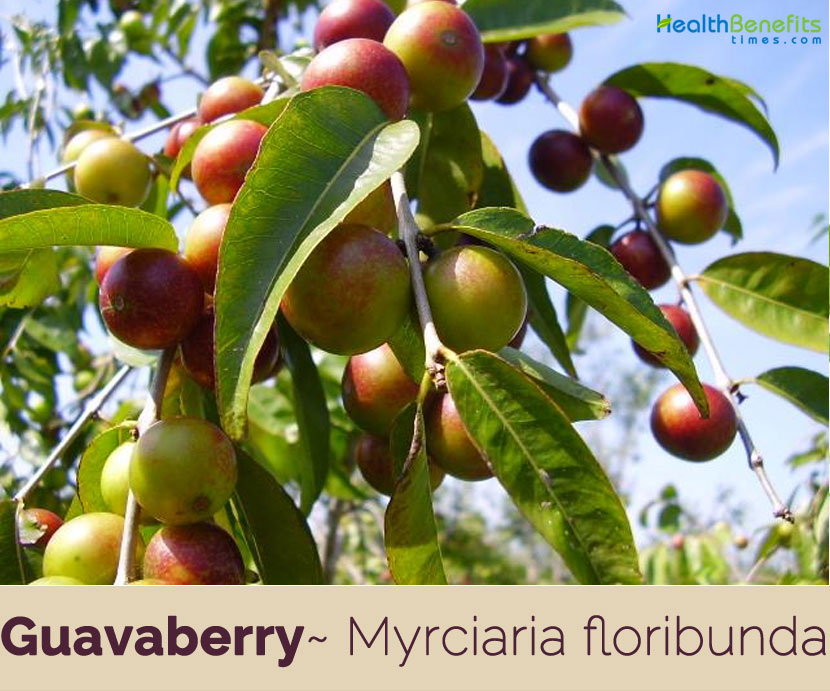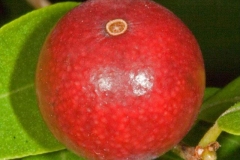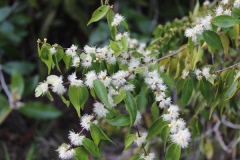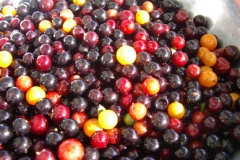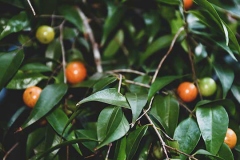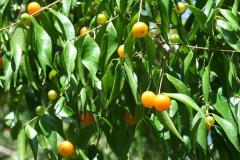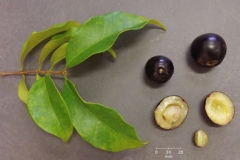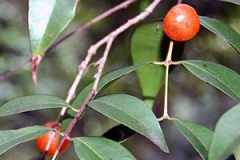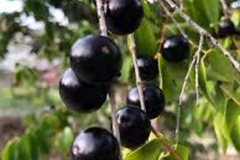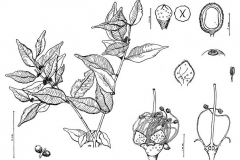| Guavaberry Quick Facts | |
|---|---|
| Name: | Guavaberry |
| Scientific Name: | Myrciaria floribunda |
| Origin | Caribbean and is now found growing wild in many locations including Central and South America, Cuba, Dominican Republic, |
| Colors | Green when young turning to either a yellow-orange or a very dark-red to a blackish purple |
| Shapes | Spherical, tropical fruit roughly the size of blueberries, each around 1 cm (0.4 in) in diameter |
| Flesh colors | Yellow-orange |
| Taste | Bittersweet, balsam-like flavor |
| Health benefits | Beneficial for treating sores, liver complaints, cancer, cardiovascular health, cataracts, and common cold. |
| Name | Guavaberry |
|---|---|
| Scientific Name | Myrciaria floribunda |
| Native | Caribbean and is now found growing wild in many locations including Central and South America, Cuba, Dominican Republic, Haiti |
| Common Names | Guavaberry, Guava berry, Rumberry |
| Name in Other Languages | Cuba: Mije, mije Colorado Dominican Republic: Mijo Dutch: Kakrioe harirazoe tataroe, Roode bosch guave, Saitjaberan El Salvador: Cabo de chivo English: Guavaberry, Guava berry, Rumberry French: Bois de basse bâtard, Bois mulâtre, Bwa débas bata, Coco caret, Koko karèt, merisier-cerise Guadeloupe and Martinique: Coco-carette, merisier-cerise, bois de basse batard Guatemala: Guayabillo Haiti: Bois mulatre Nicaragua: Escobillo Portuguese: Cambuí Puerto Rico: Mirto, murta Spanish: Cabo De Chivo, Escobillo, Guayabillo, Mijo, Mizto, Murta Surinam: Roode bosch guave, saitjaberan, kakrioe hariraroe tataroe |
| Plant Growth Habit | Attractive, very slow-growing shrub or small evergreen tree |
| Growing Climates | Dry or moist coastal woodlands |
| Soil | Prefers a fertile, deep, humus-rich soil in a sunny position. Plants can succeed in a variety of soils, though growth is poor if the pH is high |
| Plant Size | Up to 17 m (55 ft.) tall with a trunk diameter of 30 cm (1 ft.), though is more commonly 5 to 10 m (16 to 33 ft.) tall |
| Bark | Light grey or pale brown, mottled and flaking, revealing orange-brown under-bark |
| Leaf | Evergreen, opposite leaves are ovate, elliptical, or oblong-lanceolate, pointed at the apex; 1 to 3 3/16 in (2.5-8 cm) long, 1/3 to 1 3/16 in (0.8-3 cm) wide; glossy, slightly leathery, minutely dotted with oil glands |
| Flowering season | |
| Flower | Flowers, borne in small axillary or lateral clusters, are white, silky-hairy with about 75 prominent white stamens |
| Fruit Shape & Size | Spherical, tropical fruit roughly the size of blueberries, each around 1 cm (0.4 in) in diameter |
| Fruit Color | Green when young turning to either a yellow-orange or a very dark-red to a blackish purple |
| Flesh Color | Yellow-orange |
| Seed | One globular central roundish seed |
| Propagation | By seeds |
| Flavor/Aroma | Highly aromatic |
| Taste | Bittersweet, balsam-like flavor |
| Season | September to October |
Plant Description
Guavaberry fruit is an attractive, very slow-growing shrub or small evergreen tree that normally grows up to 17 m (55 ft.) tall with a trunk diameter of 30 cm (1 ft.), though is more commonly 5 to 10 m (16 to 33 ft.) tall with a short trunk and low-branching habit, forming a densely leafy rounded crown. The plant is found growing in dry or moist coastal woodlands. The plant prefers a fertile, deep, humus-rich soil in a sunny position. Plants can succeed in a variety of soils, though growth is poor if the pH is high. The bark is light grey or pale brown, mottled and flaking, revealing orange-brown under-bark.
Leaves
The plant has evergreen, opposite leaves that are ovate, elliptical, or oblong-lanceolate, pointed at the apex. It is about 1 to 3 3/16 in (2.5-8 cm) long and 1/3 to 1 3/16 in (0.8-3 cm) wide. Leaves are glossy, slightly leathery, minutely dotted with oil glands. They are dull green on top and pale green underneath. They are arranged in pairs along the ends of the branches and remain on the tree throughout the year.
Flowers
Flowers are small and insignificant, funnel-shaped with four white petals on the edge along with many white filaments arising at the center. They are borne at the leaf bases, in clusters of a few and come into bloom in the rainy season.
Fruits
Fertile flowers are followed by spherical, tropical fruit roughly the size of blueberries, each around 1 cm (0.4 in) in diameter. Unripe berries are green, while mature berries can range from yellow-orange to deep purple depending on the variety. The outer skin is thin just like a grape. Each Guavaberry features a one or more central roundish seed, which is covered by a succulent, strongly aromatic yellow-orange pulp. Guavaberries are tannic with a tangy, bitter-sweet flavor and hints of nutmeg, allspice, and pine wood. The berries are found on the Guavaberry tree, which can grow to a height of around 18 meters. They ripen in the dry season, which corresponds with winter and the festive Christmas season in its native range.
History
The Guavaberry occurs wild over a broad territory–Cuba, Hispaniola, Jamaica, Puerto Rico (including Vieques), the Virgin Islands, St. Martin, St. Eustatius, St. Kitts, Guadeloupe, Martinique, Trinidad, southern Mexico, Belize, Guatemala, El Salvador to northern Colombia; also Guyana, Surinam and French Guiana, and eastern Brazil. It has been sporadically cultivated in Bermuda, rarely elsewhere, but, throughout its natural range, when land is cleared for pastures, the tree is left standing for the sake of its fruits. The plant was introduced into the Philippines in the early 1900’s and has been included in propagation experiments in Hawaii. There is a healthy fruiting specimen at Fairchild Tropical Garden, Miami.
Traditional uses and benefits of Guavaberry
- The inner bark is boiled, and the water used for treating dermatoses.
- Juice from macerated inner bark is used as an anti-fungal or for treating sores.
- The inner bark and leaves are boiled, and the water used as an antiseptic.
- Fruits are sold by herbalists in Camaguey for the purpose of making depurative syrup.
- The decoction of the plant is taken as a treatment for liver complaints.
- Consumption of the guava berries may help prevent certain types of cancer, improve cardiovascular health, decrease the development or severity of cataracts, and can fight the common cold.
- Berries are boiled and used for liver treatment.
Culinary uses
- In Cuba, the fruits are relished out-of-hand and are made into jam, and the fermented juice is rated as “una bebida exquisita” (an exquisite beverage).
- Guavaberry liqueur, which is made from rum, is a common Christmas drink on many of the islands, particularly in Sint Maarten and the Virgin Islands.
- Sweet, orange flesh is strongly, aromatically, fragrant and makes a delicious, pungently-flavored jam or juice.
- People on the island of St. John use the preserved fruits in tarts.
- The local “Guavaberry liqueur” is made from the fruits “with pure grain alcohol, rum, raw sugar and spices” and it is a special treat at Christmas time.
- Guava berries are fantastic as a colada; a mixed drink containing coconut cream, pineapple juice and guava berry liqueur.
- They can be used whole as a garnish or muddled into cocktails and beverages.
- They are made into homemade fruit drinks, incorporated in baked goods such as cakes and pastries, made into jams and jellies, and are used for flavoring alcoholic beverages.
Other facts
- Wood is straight-grained, average texture, moderately heavy, hard, with a low susceptibility to wood eating organisms.
- It is used for general lumber.
- The wood is used for fuel and to make charcoal.
- Guavaberry is included among the nectar sources visited by honeybees in Camaguey, Cuba.
- It is used as a Christmas drink in the Caribbean Islands.
- Guavaberry liquor is a sign of the lively spirit of the people of Caribbean islands living Christmas to its fullest.
- This drink signifies the spirit of Christmas in the Virgin Islands
- The Guavaberry concoction is considered to be the national drink of Sint Maarten.
Precautions
- It has a high amount of vitamin C and needs to be avoided during pregnancy.
- Mega doses of vitamin C may increase the risk of preterm birth.
References:
http://www.theplantlist.org/tpl1.1/record/kew-131815
https://www.itis.gov/servlet/SingleRpt/SingleRpt?search_topic=TSN&search_value=27271#null
https://plants.usda.gov/core/profile?symbol=MYFL
https://en.wikipedia.org/wiki/Myrciaria_floribunda
http://tropical.theferns.info/viewtropical.php?id=Myrciaria+floribunda
https://hort.purdue.edu/newcrop/morton/rumberry_ars.html
https://gd.eppo.int/taxon/MYCFL


